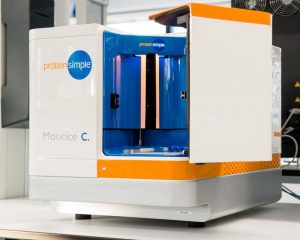Capillary Isoelectric focusing principle
- Isoelectric Point Separation is the separation of charged molecules mostly proteins or peptides that act as weak acids and bases, according to their isoelectric points(pI) or it can be said that ampholytes travel according to their charge under the influence of an electric field, in the presence of a pH gradient, until the net charge of the molecule is zero
- Isoelectric point (pI) is defined as the PH where the molecule has no charge
- Capillary isoelectric focusing (clEF) combines the high resolving power of conventional gel isoelectric focusing and the automation capabilities of instrumental techniques such as capillary electrophoresis (CE) and high-performance liquid chromatography (HPLC).
- It is a ‘high-resolution’ technique with a resolution of 0.005 pI units and less. A pH gradient is formed within the capillary by ampholytes and the proteins to be separated migrate through the ampholyte medium until they become uncharged at their pI values.
- Proteins like immunoglobulins and hemoglobins, and dilute biological solutions whose separation was difficult using IEF have all been successfully analyzed by cIEF

Capillary Electrophoresis (CE)
CIEF is a mode of CE, and some analytical parameters defined in CE can be applied to CIEF too.
Instrumentation
- One of the important features of CE is the simplicity of its instrumentation.It consists of a few components, including
(i) a high voltage power supply capable of delivering up to ± 30 kV,
(ii) two electrolyte micro-reservoirs
(iii) a fused-silica capillary filled with the running electrolyte
(iv) an on-column detector (UV-Vis detector was used in our studies)
(v) a data storage and processing device (e.g., a computing integrator)
(vi) a plexiglass safety box to protect the operator from high voltages
- Capillary electrophoresis can be carried out in various modes of operation to achieve a given separation
HPLC
- Detection of disease often relies on identifying abnormal molecules or imbalanced ratios of normal molecules in body fluids, these being reflections of abnormal metabolism.
- The study of these molecules and their interactions in both healthy and diseased states aids diagnosis and the monitoring of treatment. To carry out such investigations we need to identify,
quantify, and ultimately purify the molecules concerned. - One technique that is highly successful in achieving all three objectives is column chromatography, and particularly high performance liquid chromatography (HPLC).
- The underlying principle of chromatography is that molecules not only dissolve in liquids but can also “dissolve” (absorb) on to or interact with the surface of solids
Principles of CIEF
- In CIEF, solutes are separated on the basis of their isoelectric point (pI) values.
- A pH gradient is formed within the capillary using ampholytes with pI values that cover the
desired pH range of the CIEF experiment. - Ampholytic analytes (e.g., proteins) will migrate in the electric field until they reach the point in the pH gradient where the pH equals their pI.
- At this point, the solutes cease to move and they are focused.
- A mobilization step is then required to pass the focused analytes in front of a detector. This
is usually achieved by pressure mobilization or salt mobilization.
Applications
- A convenient CIEF system applying the standard two-step CIEF technique with pressure mobilization was used to analyze both Hb and globin chain variants
- The assay can be used for pI profiling of proteins and for monitoring structural changes (deamidation, glycosylation, etc.) during the manufacturing process and upon storage under a quality control environment
- The toxicological properties of 2-alkenals were studied using CIEF and MS demonstrating the complexity of reactions between proteins and aldehydes
- Several plant proteins have been investigated by CIEF
References
- https://onlinelibrary.wiley.com/doi/abs/10.1002/elps.200305650
- https://www.coriolis-pharma.com/analytical-capabilities/chemical-changes/capillary-isoelectric-focusing-cief
- https://www.sciencedirect.com/science/article/pii/S0149639505800121
- https://www.sciencedirect.com/topics/medicine-and-dentistry/capillary-isoelectric-focusing
- https://www.ncbi.nlm.nih.gov/pmc/articles/PMC1837629/